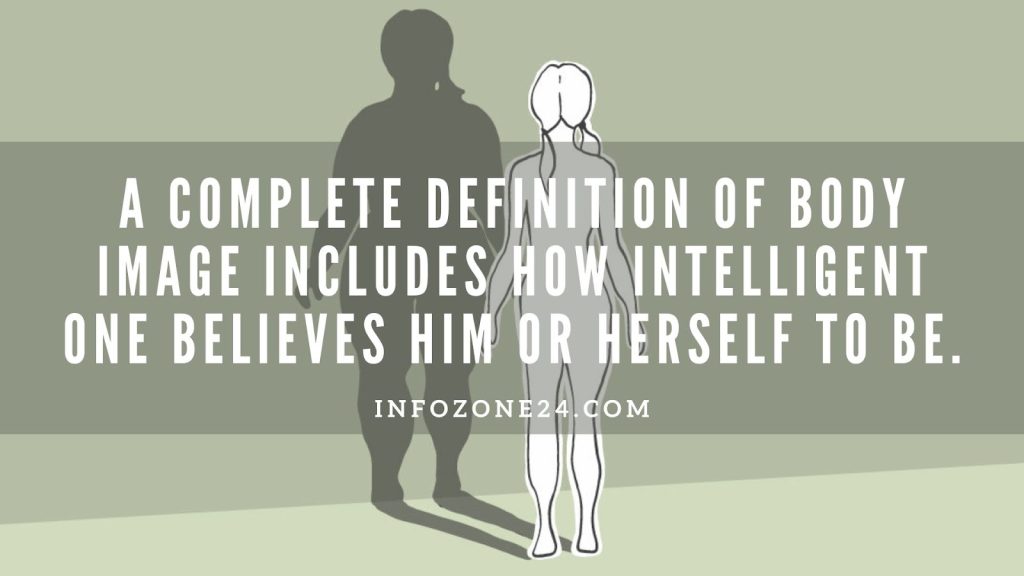Body image is usually associated with physical appearance. However, the concept of body image extends beyond a simple perception of physical appearance. It includes a person’s complete mental picture of their body, including its physical characteristics and their attitudes towards it.
In this article, we will explore the complex nature of body image. So, let’s get started!
A complete definition of body image includes how intelligent one believes him or herself to be: True or False?
The statement; “a complete definition of body image includes how intelligent one believes him or herself to be” is, in fact, incorrect.
In this statement, the term “body image” pertains to how a person sees his or her own body. It only describes aesthetics, physical appearance, and the beauty of the body.
Here, the term “body image” does not cover the cognitive aspects of a person such as intelligence. So, the statement; “a complete definition of body image includes how intelligent one believes him or herself to be” is false.
Definition of Body Image
Body image is a complex concept that involves a person’s thoughts, feelings, and perceptions of their own body, including its physical characteristics and their attitudes towards it.
It is a combination of the thoughts and feelings that you have about your body, which may range between positive and negative experiences.
Components of Body Image
Here are the components of body image that you must consider when defining the term, “Body Image”:
Perceptual Aspect:
Perceptual aspect refers to how people perceive the size and shape of their body and body parts.
Cognitive Aspect:
The cognitive aspect involves thoughts and beliefs about the body, which can lead to obsession with body shape and weight.
Affective Aspect:
Affective aspect refers to the feelings people have about their body, including happiness, disgust, and satisfaction with their shape, weight, and individual body parts.
Behavioral Aspect:
The behavioral aspect includes the actions people perform to check on, tend to, alter, or conceal their body.
Body image can range between positive and negative experiences. And you may feel at different times positive or negative or a combination of both.
Positive body image, or body acceptance, occurs when you can accept, appreciate, and respect your body, regardless of its limitations. This is not the same as body satisfaction, as you can be dissatisfied with aspects of your body yet still be able to accept it.
Understanding the many-sided nature of body image can help you develop a more positive and healthy relationship with your body. This will lead to improved self-esteem, self-acceptance, and overall well-being.
Factors Influencing Body Image
Two kinds of factors influence body image: Internal and External. Let’s explore them one by one.
Internal Factors
Let’s get to know the internal factors first.
Personality:
Personality refers to the individual traits and characteristics that shape your perception of your body. Personality traits, such as perfectionism, self-consciousness, and low self-esteem, can contribute to negative body image.
Personality can influence how you process and interpret information about your body, leading to different body image outcomes.
Upbringing:
Upbringing involves developmental factors that contribute to the formation of body image. Early experiences with body image can shape your perception of your body throughout life.
It’s important to know that parental attitudes and behaviors can influence a child’s body image development.
Family values and attitudes:
Family values and attitudes also influence your self-esteem and body image. Family values and attitudes can shape your self-perception and self-esteem, which in turn can affect body image.
Positive family values and attitudes can contribute to a positive body image, while negative ones can lead to a negative body image.
Abuse or trauma:
Experiences of abuse or trauma can negatively affect body image and self-perception, leading to negative body image and self-esteem.
Puberty:
Puberty is a critical period for body image development, as it involves significant physical changes and can lead to body image concerns.
External Factors
Now, let’s explore the external factors.
Social environment:
Social environment involves interactions with peers, coaches, and other influencers. Social interactions can shape your perception of your body and influence body image development.
Positive social interactions can contribute to a positive body image, while negative ones can lead to a negative body image.
Media, advertising, and societal pressures:
Media and advertising can promote unrealistic body standards, leading to negative body image and self-esteem.
Societal pressures, such as the emphasis on thinness and muscularity, can also contribute to negative body image.
Background:
Background factors include racial, geographic, or other context-specific factors. They can influence body image development.
You may face different societal pressures and expectations based on your race, ethnicity, or geographic location.
Acceptance or rejection about your body:
The impact of praise or criticism on body image cannot be overlooked.
Positive feedback can contribute to a positive body image, while negative feedback can lead to a negative body image.
Participation in sports or activities:
Participation in sports or activities can lead to increased body obsession and dissatisfaction, potentially contributing to negative body image.
Positive and Negative Body Image
Let’s get to know what positive and negative body image mean.
Positive Body Image
Positive body image is characterized by body satisfaction, acceptance, and a healthy relationship with your body. If you have a positive body image
- You accept and appreciate your body
- You have a broad concept of beauty
- You take steps to care for your body in ways that feel good
This positive outlook is associated with higher self-esteem, self-acceptance, and healthy lifestyle behaviors.
Negative Body Image
On the other hand, negative body image is marked by dissatisfaction and a desire for change. It can lead to an obsession with body shape and weight, as well as unhealthy lifestyle behaviors such as dieting, over-exercising, or social isolation.
Negative body image is associated with lower self-esteem, self-acceptance, and an increased risk of mental health conditions, including eating disorders and depression.
The Role of Intelligence in Body Image
Intelligence is a many-sided concept that can influence how you perceive your body image. Emotional intelligence, in particular, is associated with body image.
Emotional intelligence refers to the capacity to be aware of, control, and express one’s emotions, as well as understand personal and other people’s emotions. So that they can handle interpersonal relationships effectively.
Individuals with higher emotional intelligence may be better equipped to manage negative emotions related to body image and may be more likely to have a positive body image.
On the other hand, individuals with lower emotional intelligence may be more vulnerable to negative body image.
Additionally, intelligence may play a role in the relationship between body image and self-esteem. Research has suggested that individuals with higher intelligence may have higher self-esteem, which in turn may lead to a more positive body image.
Strategies for Improving Body Image
There are several strategies that you can use to improve your body image and promote a positive relationship with your body.
Identify and Challenge Negative Thoughts:
You need to develop an awareness of negative self-talk and challenge these thoughts with positive affirmations. This can help improve body image.
Recognize the Underlying Motivation for Criticism:
You should understand the reasons behind self-criticism related to body image. This can help in addressing and reframing negative perceptions.
Appreciate Your Body for What It Can Do:
You can focus on the capabilities of the body and be thankful for its abilities. This can shift the focus from appearance to functionality, promoting a more positive body image.
Shift Your Focus to How Your Body Performs, Not What It Looks Like:
You need to emphasize the functionality and performance of your body, rather than its appearance. This will contribute to a healthier body image.
Practice Positive Self-Talk:
You can engage in positive self-talk and reframe negative thoughts about your body. This can also help foster a more positive body image.
Seek Support from Body-Positive Individuals:
Spend time with people who have a body-positive outlook. This can influence your own body image and self-perception.
By implementing these strategies, you can work towards developing a more positive and healthy body image.
Conclusion
So, the statement; “a complete definition of body image includes how intelligent one believes him or herself to be” is false. A complete definition of body image extends beyond just physical appearance.
You need to understand the different components of body image. This can help you recognize and counter negative influences on your body image.
Moreover, you should develop a positive view of both physical characteristics and intellectual abilities.
Michael C Vang is a passionate blogger. He has been blogging since 2013 on a variety of topics. He is committed to creating informative and engaging content that helps readers learn more about everything.



